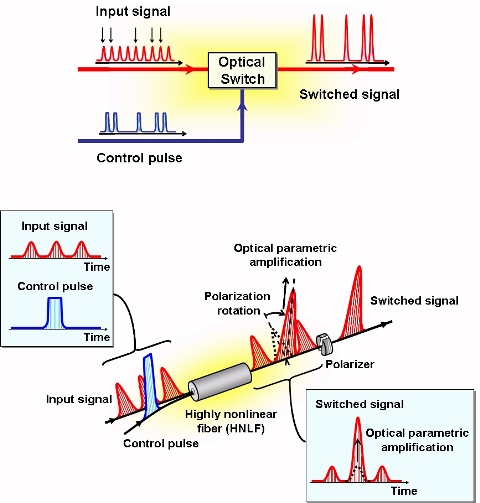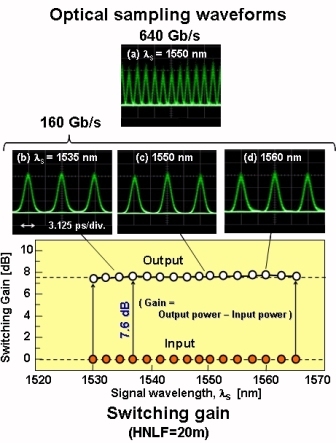Archived content
NOTE: this is an archived page and the content is likely to be out of date.
Fujitsu and HHI Develop World's First Ultra High-Speed Optical Fiber Switch with Power Amplification Features
Ultra high-speed signal processing verified at 640 gigabits per second
Fujitsu Laboratories Ltd.,Fraunhofer Institute for Telecommunications, Heinrich-Hertz-Institut
-
[1] highly nonlinear optical fibers
A single-mode optical fiber that has a distinctive structure that increases the nonlinear optical effect. It produces ten times the nonlinear optical effect of conventional optical fibers. In the future, with the use of photonic crystalline fibers and other nano-optical devices, it is expected that the performance will be enhanced tenfold above current levels.
-
[2] terabit
Tera is equivalent to 10 to the 12th power. One terabit is equivalent to 1000 gigabits.
-
[3] Optical regeneration
Technology whereby a degraded optical signal is brought back to its original quality. It consists of Re-amplification, Re-timing, and Re-shaping, and is often referred to as 3R Regeneration.
About Fujitsu Laboratories Ltd.
Founded in 1968 as a wholly owned subsidiary of Fujitsu Limited, Fujitsu Laboratories Limited is one of the premier research centers in the world. With a global network of laboratories in Japan, China, the United States and Europe, the organization conducts a wide range of basic and applied research in the areas of Multimedia, Personal Systems, Networks, Peripherals, Advanced Materials and Electronic Devices.
For more information, please see: http://www.labs.fujitsu.com/en/
About Heinrich-Hertz Institut
Research and development activities at the Heinrich-Hertz-Institut (HHI) are concentrated to expand the principles of information technology and to demonstrate new applications for new products in partnership with the industry.
The core competencies of HHI are in the areas of Photonic Networks, Mobile Broadband Systems and Electronic Imaging Technology for Multimedia. In its three main working areas the HHI is a valued partner in national and international cooperative research and development projects.
Nearly half of the HHI staff is working in the Photonics area. The objective of research is to make substantial contributions to the development of photonic networks and advanced photonic components. HHI has been involved in optical transmission research from the very beginning. Along with this expertise a full range of design, measurement and experimental capabilities exists for photonic networks, as well as for InP based photonic components and photonic integrated circuits, complemented by silica on silicon and polymer devices. We put science into action! For more information, please see: http://www.hhi.fraunhofer.de/english
Technical Contacts
Network Systems Lab
![]() E-mail: photonicssytem@ml.labs.fujitsu.com
E-mail: photonicssytem@ml.labs.fujitsu.com
Company:Fujitsu Laboratories Ltd.
Press Contacts
![]() E-mail: info@hhi.fraunhofer.de
E-mail: info@hhi.fraunhofer.de
Company:Heinrich-Hertz-Institut
Technical Contacts
![]() E-mail: otdm@hhi.fraunhofer.de
E-mail: otdm@hhi.fraunhofer.de
Website:http://www.hhi.fraunhofer.de/otdm
Company:Heinrich-Hertz-Institut
All company and product names mentioned herein are trademarks or registered trademarks of their respective companies.
Date: 21 January, 2005
City: Tokyo and Berlin
Company:
Fujitsu Laboratories Ltd.,
Fraunhofer Institute for Telecommunications, Heinrich-Hertz-Institut,
,
,
,

